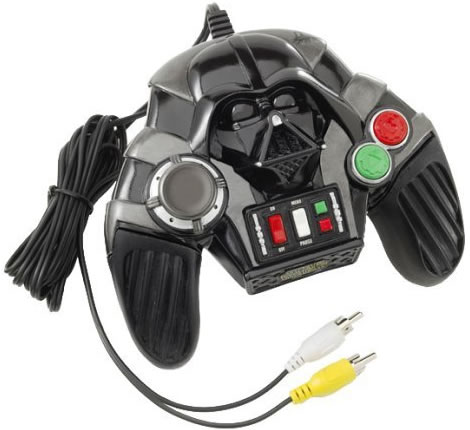Joystick
A joystick is an input device consisting of a stick that pivots on a base and reports its angle or direction to the device it is controlling. Joysticks are often used to control video games, and usually have one or more push-buttons whose state can also be read by the computer. A popular variation of the joystick used on modern video game consoles is the analog stick.The joystick has been the principal flight control in the cockpit of many aircraft, particularly military fast jets, where centre stick or side-stick location may be employed (see also Centre stick vs side-stick).
Joysticks are also used for controlling machines such as cranes, trucks, underwater unmanned vehicles and zero turning radius lawn mowers. Miniature finger-operated joysticks have been adopted as input devices for smaller electronic equipment such as mobile phones.
Joysticks can be used within first-person shooter games, but generally provide less accurate control than a combination of mouse and keyboard input.
Technical details
Most joysticks are two-dimensional, having two axes of movement (similar to a mouse), but one and three-dimensional joysticks do exist. A joystick is generally configured so that moving the stick left or right signals movement along the X axis, and moving it forward (up) or back (down) signals movement along the Y axis. In joysticks that are configured for three-dimensional movement, twisting the stick left (counter-clockwise) or right (clockwise) signals movement along the Z axis. These three axes - X Y and Z - are, in relation to an aircraft, roll, pitch, and yaw.
An analog joystick is a joystick which has continuous states, i.e. returns an angle measure of the movement in any direction in the plane or the space (usually using potentiometers) and a digital joystick gives only on/off signals for four different directions, and mechanically possible combinations (such as up-right, down-left, etc.). (Digital joysticks were very common as game controllers for the video game consoles, arcade machines, and home computers of the 1980s.)

Additionally joysticks often have one or more fire buttons, used to trigger some kind of action. These are simple on/off switches.
Some joysticks have force feedback capability. These are thus active devices, not just input devices. The computer can return a signal to the joystick that causes it to resist the movement with a returning force or make the joystick vibrate.
Most I/O interface cards for PCs have a joystick (game control) port. Modern joysticks (as of 2007) mostly use a USB interface for connection to the PC.
History
Joysticks were originally controls for an aircraft's ailerons and elevators.
The name "joystick" is thought to originate with early 20th century French pilot Robert Esnault-Pelterie.[1] There are also competing claims on behalf of fellow pilots Robert Loraine, James Henry Joyce and Mr A.E. George. The latter was a pioneer aviator who with his colleague Mr. Jobling built and flew a biplane at Newcastle, England in 1910. He is alleged to have invented the "George Stick" which became more popularly known as the joystick. The George and Jobling aircraft control column is in the collection of the Discovery Museum in Newcastle Upon Tyne, England. The joystick itself was present in early planes, though the mechanical origins themselves are uncertain.
The first electrical 2-axis joystick was probably invented around 1944 in Germany. The device was developed for targeting the glide bomb Henschel Hs 293 against ship targets. Here, the joystick was used by an operator to steer the missile towards its target. This joystick had on-off switches rather than analogue sensors, i.e. a digital joystick. The signal was transmitted from the joystick to the missile by a thin wire.
This invention was picked up by someone in the team of scientists assembled at the Heeresversuchsanstalt in Peenemünde. Here a part of the team on the German rocket program was developing the Wasserfall missile, a variant of the V-2 rocket, the first ground-to-air missile. The Wasserfall steering equipment converted the electrical signal to radio signals and transmitted these to the missile.
The Atari standard joystick, developed for the Atari 2600 was a digital joystick, with a single 'fire' button, and connected via a DE-9 connector, the electrical specifications for which was for many years the 'standard' digital joystick specification. Joysticks were commonly used as controllers in first and second generation game consoles, but then gave way to the familiar Game pad with the Nintendo Entertainment System and Sega Master System in 1985 and 86, though joysticks - especially arcade-style ones - were and are popular after-market add-ons for any console.
The joystick has found a new lease of life for flight control in the form of a 'sidestick' - a controller similar to a games joystick but which is used to control the electronics of the latest aircraft. Almost the entire family of Airbus aircraft (with the exception of the A300 and A310) up to the A380, the largest commercial aircraft in aviation, use the 'sidestick' which saves weight, improves movement and visibility in the cockpit and is said to be safer in the event of an accident than the traditional 'control yoke'.


No comments:
Post a Comment